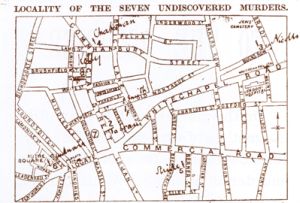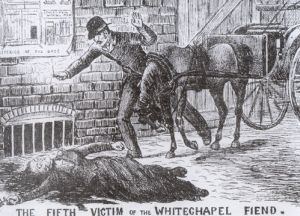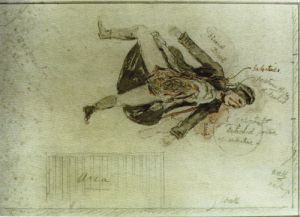|
the parish
of Whitechapel: prostitution and the victims of murder

|
Whitechapel
and prostitution
|
 |
The
Whitechapel murders
|
 |
The
victims of Jack the Ripper
|

|
Whitechapel murders home page
|
These
poor people had souls like anybody else
Comment
by the jury foreman at the inquest into the
death of Mary Nichols
As
reported in The Daily Telegraph; 18th September 1888
|
Whitechapel
and
prostitution
|
The Whitechapel
district of London at the end of the nineteenth century was generally regarded as being a ‘horrible black labyrinth, reeking from end to end and
swarming with human vermin, whose trade is robbery and whose recreation
is murder’. While such was apparently true for some areas, as a
generalisation it was inaccurate. The Poverty Map of 1889 certainly
showed many streets with inhabitants described as ‘lowest class -
vicious semi criminals’, or as ‘very poor – casual, chronic
want’, but these were often sharply juxtaposed with streets populated
by ‘middle class - well to do people’, and others by inhabitants
with ‘fairly comfortable - good ordinary earnings’, although the
majority of streets seemed to be a mix of types. The classification of
‘poor’ on this map corresponded to an income of 18s to 21s a week for a
moderate family but there were many who earned far less than that.
A survey of pauperism in London in 1869
revealed that within the Metropolis
(population 2,802,000 in 1861) there were no fewer than 34,609 paupers
indoors and 103,954 paupers outdoors making a total of 138,563. In
Whitechapel in that year there were 1192 adult and children paupers
indoors and 1234 adult and 1700 children under 16 paupers outdoors
making a total of 4126 for the parish.
The conditions undoubtedly provided
contemporaneous writers with an endless opportunity for florid prose. Whitechapel and thereabouts
was described as a maze of courts and narrow
streets of low houses, nearly all the doors of which are open. The image
is one of streets teeming with ragged individuals for whom alcohol
consumption was
preferable alternative to food and lodgings. People appeared to exist
rather than live within and among houses that were black and grim and
lodge within rooms that are described as being clean compared with the
guests.
One commentator observed areas to be;
‘Black and noisome, the road
sticky with slime, and palsied houses, rotten from chimney to cellar,
leaning together, apparently by the mere coherence of their ingrained
corruption. Dark, silent, uneasy shadows passing and crossing - human
vermin in this reeking sink, like goblin exhalations from all that is
noxious around. Women with sunken, black-rimmed eyes, whose pallid faces
appear and vanish by the light of an occasional gas-lamp, and look so
like ill-covered skulls that we start at their stare.’
Another
observer reported that;
‘Some
years ago, it was fashionable to "slum" - to walk gingerly
about in dirty streets, with great heroism, and go back West again, with
a firm conviction that "something must be done." And something
must. Children must not be left in these unscoured corners. Their
fathers and mothers are hopeless, and must not be allowed to rear a
numerous and equally hopeless race. Light the streets better, certainly;
but what use in building better houses for these poor creatures to
render as foul as those that stand? The inmates may ruin the character
of a house, but no house can alter the character of its inmates.’
An insight into the lives of
the poor comes from the very eloquent summaries of the coroner, Wynne E
Baxter who presided over the inquests of several of the Ripper victims. In
particular, he made some very evocative comments at the conclusion of
the inquest into the death of Annie Chapman. Of Chapman’s life he said:
‘She [Chapman] lived principally in the common lodging houses
in the neighbourhood of Spitalfields, where such as she herd like
cattle, and she showed signs of great deprivation, as if she had been
badly fed. The glimpse of life in these dens which the evidence in this
case discloses is sufficient to make us feel that there is much in the
nineteenth century civilisation of which we have small reason to be
proud; but you [the jury] who are constantly called together to
hear the sad tale of starvation or semi starvation, of misery,
immorality, and wickedness, which some of the occupants of the 5000 beds
in this district have every week to relate to coroner’s inquests, do not
require to be reminded of what life in a Spitalfields lodging house
means.’
And of the place where
Chapman was murdered he said:
‘This
place is a fair sample of a large number of houses in the neighbourhood.
It was built, like hundreds of others, for the Spitalfields weavers, and
when hand-looms were driven out by steam and power, these were converted
into dwellings for the poor. Its size is about such as a superior
artisan would occupy in the country, but its condition is such as would
to a certainty leave it without a tenant. In this place seventeen
persons were living, from a woman and her son sleeping in a cat’s-meat
shop on the ground floor to Davis and his wife and their three grown-up
sons all sleeping together in an attic. The street door and the yard
door were never locked, and the passage and yard appear to have been
used constantly by people who had no legitimate business there. There is
little doubt that the deceased knew the place, for it was only 300 or
400 yards from where she lodged. If so, it is quite unnecessary to
assume that her companion had any knowledge – in fact, it is easier to
believe that he was ignorant both of the nest of living beings by whom
he was surrounded, and of their occupations and habits. Some were on the
move late at night; some were up long before the sun.’
Shelter for those lucky enough to be able to afford a bed for the
night was provided by single rooms in lodging houses, many subdivided
for that purpose and offering little by way of facilities. Those
men and women who could not afford to sleep in a bed in a lodging house
would end up at the casual ward of the workhouse or on the street. The
casual ward provided temporary shelter in the form of ‘dormitories set
out like barracks’ in exchange for work such as picking
oakum – the loose fibre obtained by teasing out old ropes which was then sold to ship-builders for mixing
with tar and use as caulking.
Henry Mayhew wrote on the matter of labour and the poor around the
middle of the nineteenth century. He convened a meeting of needlewomen
and slop-workers in order that he could investigate their income. The
women revealed their lives of poverty and of prostitution as they spoke
at the meeting:
‘I am a slop-worker, and
sometimes make about 3s 6d a week, and sometimes less. I have been drove
to prostitution, sometimes, not always through the bad prices. For the
sake of my lodgings and a bit of bread I’ve been obligated to do what
I am very sorry to do, and look upon with disgust. I can’t live by
what I get by work. The woman who employs me and several more besides,
gets 11d and 1s a pair for the trousers we make, and we get only 4d or
5d. We can’t do more than a pair a day, and sometimes a pair and a
half. It’s starving. I can’t get a cup of tea and a bit of bread. I
was married, and am left a widow, and have been forced to live in this
distressed manner for the last four years. I’ve been to several
different people to get work but they are all alike in taking advantage
of our unfortunate situation.’
‘I am a shirt-maker and make about three shirts a day, at 2¼d apiece, every one of them having seven button holes. I
have to get up at six in the morning, and work till twelve at night, to
do that. I buy thread out of the price; and I cannot always get work. I
sometimes make trousers; but I have not constant work with both put
together. I sometimes make 2s 6d a week; 3s is the most I ever made, and
I have to buy thread out of that. I am now living with a young man. I am
compelled to do so, because I could not support myself. I know he would
marry me if he could. He is a looking-glass frame maker. He has earned
nothing for the past three weeks. If he had the money I know he would
marry me.’
‘My firm belief before God and
man, is that three out of every four young women of London who do slop
work are obliged to resort to either private or public prostitution to
enable them to live. But I hope better things are coming at last, and I
hope that, public attention now being called to these matters, the
oppressed will be oppressed no longer. But I am sorry to say the good
are not always the powerful, nor the powerful always the good.’
It was apparent that most women in similar straights had no
change of clothing; had pawned everything that they could possibly pawn,
including their beds, shoes, and underclothing; that none had meat as part of
a meal on any day of the week from their own endeavours; and that several had
not eaten at all for periods of up to two days. The conclusion was that
one quarter of women who worked in these trades as a whole, and one half
of those who did not have a husband resorted to prostitution. Figures
for 1857 indicated that across the seventeen Metropolitan Police
Districts there were a total of 8600 prostitutes, of which 5063 were
classified as ‘Low, infesting low neighbourhoods.’ In
1868 the figures were a little improved with a total of 6515 prostitutes
across 20 Metropolitan Police Districts of which 4349 were ‘In low
neighbourhoods.’ Of this latter figure, 623 were active in the
Whitechapel police division and there were 126 places where they lodged.
By the provision of such a service one can only imagine that there can
have been no shortage of clients.
There is a temptation to think that
because Mayhew's meeting was concerned with investigating the low wages
earned by these women, they would be inclined to overstate their case.
However, I doubt that such is true and given the many similar and
supporting observations from other independent sources, the
descriptions of the miserable existence of these women was probably
depressingly accurate. Almost without exception they engaged in
prostitution out of absolute necessity rather than from choice.
It is interesting to note the two distinct categories of prostitution;
private and public. Public prostitution is self-explanatory and private
prostitution one imagines is more ‘relationship’ based but still
reliant upon the man giving money to the woman even though her sexual
availability is more along the lines of those in a more conventional
relationship. The comment of one woman is informative; ‘I have not
resorted to prostitution any further than with my young man. I still
keep company with him, and we wish to get married.’ The partners in
this relationship seem to spend much time together but their
independence and distance is obvious. Frequent talk of marriage and
husbands underlines the perception of these women that they were outwith respectability and somehow marriage would change their
circumstances. Often women continued with street prostitution while
living with a man - Eddowes had been living with the same man for seven
years in common lodging houses - but the men either did not know or did
not admit to knowing that their women continued to work the streets.
John Kelly with whom Catharine Eddowes lived claimed that he ‘did not know of
her going out for immoral purposes at night. She never brought me money
in the morning after being out at night,’ was his response. It is also
interesting that the population, even in rough areas, was to some extent
in denial about the existence of prostitution and several witnesses at
the inquests were emphatic that they were not aware of lodgings or yards
being used for ‘immoral purposes’ even though many took money for
lodging from the women.
Payment for the beds in common lodging houses
was on a daily basis with cash up front. The price of a single bed was 4
pence, and 8 pence a night could secure a double bed. The price for sex
on the street was probably no more than a few pennies; an extremely
cheap way to catch venereal disease and a pathetic income for the risk
of losing one’s life! There was no post mortem
evidence to suggest that any of the victims had contracted a venereal
disease but there was an absolute epidemic among the prostitute
population during the late eighteen hundreds with syphilis and
gonorrhoea prevalent.
Women were allowed to take men back with them to
the common lodging house and there they could presumably spend the
night. But if a prostitute needed to earn more money then
she would need to work the streets and engage with as many clients as
she could find. Staying out late at night, even when a woman had secured
her lodgings, was not considered unusual and in the words of the coroner
at the Elizabeth Stride inquest prostitution was, ‘an offence very venial among
those who frequented the establishment [common lodging house].’
Those prostitutes not having a bed to use would have to have sex on the street. It is clear from
testimony during the inquests that many prostitutes knew of places they
could use that afforded relative seclusion. Quiet streets, yards,
passages, alleys and courts were all likely places to use if a room were
not available. Prices inevitably reflected this and the sex act on the
street was unlikely in most cases to involve any horizontal activity;
more likely, the act would take place against a wall giving rise to the
slang reference to a prostitute as a ‘twopenny upright’ which
reflects both the price and the attitude of the encounter.
Each of the supposed Ripper
victim’s was unmarried and lived on and off in common lodging houses
with the exception of Kelly who had the luxury of her own room.
Throughout the inquests there was constant reference to the victims’
unstable existence and there was much about their lives that was so
negative as to necessitate a measure of invention in order to bring a
little colour into an otherwise very grey world. For several of the
victims, stories that they told about their lives proved to be untrue.
The women were constantly on the move from one house to another at all
hours of the day and night. They were in and out; one minute supping
beer in the company of faces they recognised then consorting with
faceless paramours the next. They had no alternative but to flirt with
danger in the desperate pursuit of subsistence; for many women it ended
in premature and violent death.
|
Back
to top
The
Whitechapel murders
|
The Metropolitan
police defined eleven murders that at some stage looked as though they
may have been attributable to the serial killer known as Jack the
Ripper. To cite their information the full list of possible victims is
as follows:
|
DATE
|
VICTIM
|
CIRCUMSTANCES
|
|
03 April 1888
|
Emma
Elizabeth Smith
|
Assaulted and
robbed in Osborn Street, Whitechapel. Died the following
day
|
|
07 August
1888
|
Martha Tabram
|
Murdered
George Yard Buildings, George Yard, Whitechapel
|
|
31 August
1888
|
Mary Ann Nichols
|
Murdered
Buck’s Row, Whitechapel
|
|
08 September
1888
|
Annie Chapman
|
Murdered rear
yard 29 Hanbury Street, Spitalfields
|
|
30 September
1888
|
Elizabeth
Stride
|
Murdered yard
side of 40 Berner Street St Georges-in-the-East
|
|
30 September
1888
|
Catharine
Eddowes
|
Murdered
Mitre Square, Aldgate, City of London
|
|
09 November
1888
|
Mary Jane
Kelly
|
Murdered 13
Miller’s Court, 26 Dorset Street, Spitalfields
|
|
20 December
1888
|
Rose Mylett
|
Murdered
Clarke’s Yard, High Street, Poplar
|
|
17 July 1889
|
Alice
McKenzie
|
Murdered
Castle Alley, Whitechapel
|
|
10 September
1889
|
Female torso
|
Found under
railway arch Pinchin Street Whitechapel
|
|
13 February
1891
|
Frances Coles
|
Murdered
under railway arch Swallow Gardens, Whitechapel
|
All of the above murders remained unsolved but that alone is no reason
to assume that they were all conducted by the same person, for probably
they were not. Over the years and largely as a result of the Macnaghten
Memorandum of 1894 in which the Chief Constable Sir Melville Macnaghten
made known his beliefs, the list has been reduced to five likely Ripper
victims. Mary Nichols, Annie Chapman, Elizabeth Stride, Catharine
Eddowes, and Mary Kelly have become the generally accepted victims of Jack the
Ripper.
Because of the immediate similarities, these five cases were a good basis
upon which to make an analysis of crime scene and post mortem findings
and a comprehensive tabulation of this data has been undertaken and
reported elsewhere.
After considering the data in detail in the following pages I shall then
compare the killer’s signature components with what details are
available for the remaining Whitechapel murder victims. In addition, and
largely following attempts by others to identify The Camden Town Murder as a
Ripper victim I shall also consider in some detail at the murder of Emily
Dimmock:
|
DATE
|
VICTIM
|
CIRCUMSTANCES
|
|
12 September
1907
|
Emily Dimmock
|
Murdered 29
St Paul’s Road, Camden Town
|
|
Back
to top
|
The
victims of Jack the Ripper |
This
sections gives brief details about the five victims commonly attributed
to Jack the Ripper. These five murders shared several common features
and will be examined in greater detail later. Nichols, Chapman,
Stride, Eddowes, and Kelly are known as the canonical victims because
they supposedly form series that is generally accepted and authoritative.
However, this group was established largely on the basis of the
Macnaghten report of 1894, which listed these five women as victims of
the Ripper on somewhat arbitrary
grounds.
|
| |
Mary
Ann Nichols - aged 43
At the time of her death Nichols wore a black straw bonnet trimmed with black velvet, a reddish brown ulster with large brass buttons, a brown linsey frock, white flannel
chest cloth, black ribbed wool stockings, two petticoats (one grey wool,
one flannel and both stencilled on bands 'Lambeth Workhouse', brown
stays (short) flannel drawers, and men's elastic (spring) sided boots
with the uppers cut and steel tips on the heels.
Nichols' possessions when her body was
discovered were; a comb, a white pocket handkerchief, and a broken piece
of mirror.
|
 |
| |
Annie
Chapman - aged 47
At the time of her death Chapman wore a long black figured coat that came down to her knees, a black
skirt, a brown bodice, another bodice, 2 petticoats, a large pocket worn
under the skirt and tied about the waist with strings (empty when found,
lace-up boots, red and white striped woollen stockings, neckerchief
(white with red border - folded tri-corner and knotted at the front of
her neck), three brass rings (missing after the murder)
Her possessions were; a scrap of
muslin, one small toothcomb, one comb in a paper case, a scrap of
envelope containing two pills |
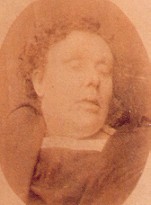 |
|
|
Elizabeth
Stride - aged 44
Stride wore a long black
cloth jacket (fur-trimmed around the bottom with red rose and white
maiden hair fern pinned to it), black skirt, black crepe bonnet, checked
neck scarf knotted on the left side, dark brown velveteen bodice, 2
light serge petticoats, white chemise, white stockings, spring-sided
boots.
Her possessions were; 2 handkerchiefs,
a thimble, a piece of wool around a card. In the pocket of her
underskirt were the following; a key (as of a padlock), a small piece of
lead pencil, six large and one small button, a comb, a broken piece of
comb, a metal spoon, a hook (as from a dress), a piece of muslin, one or
two small pieces of paper. She was found clutching a packet of
cachous in her hand.
|
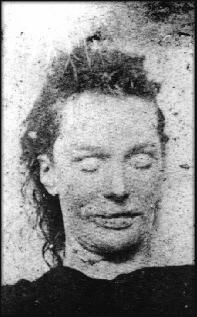 |
| |
Catharine
Eddowes - aged 46
When found, Eddowes was wearing a
black straw bonnet in green and black velvet with black beads and black
strings worn tied to the head, a black cloth jacket trimmed around the
collar and cuffs with imitation fur, a dark green chintz skirt with
three flounces, a man's white vest, a brown linsey bodice, a grey
stuffed petticoat, a very old alpaca skirt (worn as undergarment), very
old ragged blue skirt with red flounces (worn as undergarment), a white
calico chemise, no drawers or stays, a pair of men's lace-up boots
(right boot repaired with red thread), a piece of red gauze silk worn as
a neckerchief, a large white pocket handkerchief, a large white cotton
handkerchief, 2 unbleached calico pockets with tape strings, a blue
stripe bed ticking pocket, brown ribbed knee stockings (darned with
white cotton). He
possessions were; 2 small blue bags, 2 short clay pipes, a tin box
containing tea, a tin box containing sugar, an empty tin matchbox, 12
pieces of white rag, a piece of white coarse linen a piece of white
shirting, a piece of red flannel with pins and needles, 6 pieces of
soap, a small toothcomb, a white handled table knife, a metal spoon, a
red leather cigarette case, a ball of hemp, a piece of old white apron
with repair, several buttons and a thimble, two pawn tickets with false
addresses, a printed handbill, portion of a pair of spectacles and one
red mitten |
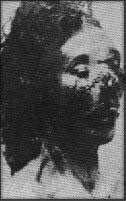 |
|
|
Mary Jane Kelly - aged 25
Mary Jane Kelly was murdered in her own
home - a rented single room. Her face was so badly mutilated by her
killer that an image of her features does not exist. The image shown is
from a drawing that appeared in the Illustrated Police News 17 November
1888 - there is, however, no reason to assume that it is a good, or even
approximate, likeness.
She wore only a chemise when she was
killed. Her clothes were folded neatly on a
chair and her boots were in front of the fireplace.
|
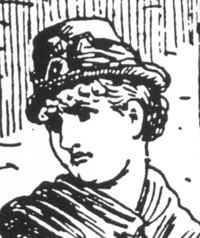 |
|
Post mortem images reproduced
by kind permission of the Metropolitan Police
|
|
Back
to top
|
 |
 |
 |
 |
 |
 |
 |
 |
|
home |
Whitechapel |
Whitechapel victims |
interpretation of findings |
how many victims? |
Mary Jane Kelly |
resources |
by ear and eyes |
© karyo magellan 2001-2006
|
